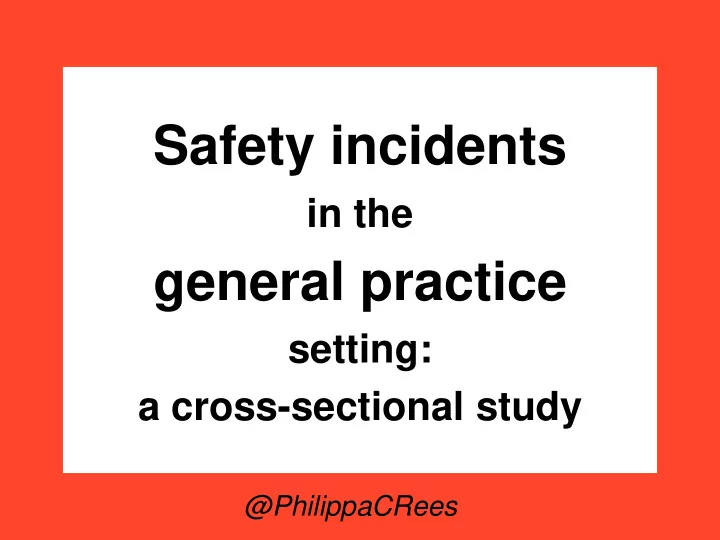

Safety incidents in the general practice setting: a cross-sectional study @PhilippaCRees
Safety incidents in the general practice setting: a mixed methods cross-sectional study Ms. Philippa Rees Dr. Colin Powell Mr. Peter Hibbert Prof. Andrew Carson-Stevens Dr. Meredith Makeham Prof. Adrian Edwards Dr. Ben Carter Dr. Huw Williams Dr Sharon Mayor Prof. Aziz Sheikh Dr Sukhmeet Panesar Sir. Liam Donaldson Prof. Anthony Avery This project was funded by the National Institute for Health Research HS&DR (project number 12/64/118) Department of Health Disclaimer: The views and opinions expressed therein are those of the authors and do not necessarily reflect those of the HS&DR, NIHR, NHS or the Department of Health.
One of the WORST CHILD MORTALITY rates in Western Europe
• 3,000,000 deaths 26% of child deaths have identifiable failures in care prevented annually
National Reporting & Learning System (NRLS)
1 Under-reporting 2 Reporting bias 3 Selective deposit
Aims
Explore the nature, range and severity of safety incidents involving children as reported to the NRLS from general practice in England and Wales to include: 1 2 3 Incident Contributory Harm characteristics factors severity
Classification system Read free text Classify harm Classify what Classify contributory severity happened factors New concepts emerge Check inter-coder reliability Iterate frameworks Discuss Re-classify findings
Results
1788 included reports
The number of harmful and non-harmful incidents described for each incident type 800 700 600 Number of incidents 500 400 300 Harm 200 No harm 100 0 Incident types
Staff mistakes Resource issues Documentation errors (n=145) (n=145) (n=207) Treatment availability Inadequate patient records Human resources Transfer of records Equipment availability & safety Reported paediatric safety incidents Child protection protocol Communication Staff knowledge Poor continuity of care Treatment protocol Other clinical skills Treatment provision errors Acutely illness Other protocol Errors in patient assessment Inadequate guidelines/ protocols Failure to follow Clinical skills Other (n=194) protocol errors (n=109) (n=93)
1 Medication provision 2 Assessment and referral 3 Safe treatment
Medication incidents
Prescribing n=119 Dispensing n=53 Administering n=25 Adverse reactions n=9
Risperidone dose (5mg BD) recommended by child and adolescent mental health team for a child that they had assessed. The family doctor requested a consultant’s opinion and was informed that this was the dose agreed by the team. Patient later presented with signs of toxicity (dyskinetic tongue) .
Staff mistakes Resource issues Documentation errors (n=145) (n=145) (n=207) Treatment availability Inadequate patient records Human resources Transfer of records Equipment availability & safety Reported paediatric safety incidents Child protection protocol Communication Staff knowledge Poor continuity of care Treatment protocol Other clinical skills Treatment provision errors Acutely illness Other protocol Errors in patient assessment Inadequate guidelines/ protocols Failure to follow Clinical skills Other (n=194) protocol errors (n=109) (n=93)
Assessment & Referral
Mother of a 3-year-old noticed blood on child’s pyjamas . Physician diagnosed cystitis and prescribed antibiotics without examining child or taking a urine sample . Bleeding in a 3-y-old is unusual , and physician should have sought a paediatric review. Patient seen by paediatrician 5 d later when it was discovered that child had been sexually abused .
Staff mistakes Resource issues Documentation errors (n=145) (n=145) (n=207) Treatment availability Inadequate patient records Human resources Transfer of records Equipment availability & safety Reported paediatric safety incidents Child protection protocol Communication Staff knowledge Poor continuity of care Treatment protocol Other clinical skills Treatment provision errors Acutely illness Other protocol Errors in patient assessment Inadequate guidelines/ protocols Failure to follow Clinical skills Other (n=194) protocol errors (n=109) (n=93)
Safe treatment & procedures
Patient saw family doctor with 3-week history of symptoms of diabetes . After documenting high blood sugar , she was started on an oral hypoglycemic drug . Brought to emergency department with blurred vision. Patient was treated and not referred inappropriately promptly.
Patient attended with laceration to nose caused by someone throwing a canister . Wound glued but treatment of laceration caused eye to be glued
Staff mistakes Resource issues Documentation errors (n=145) (n=145) (n=207) Treatment availability Inadequate patient records Human resources Transfer of records Equipment availability & safety Reported paediatric safety incidents Child protection protocol Communication Staff knowledge Poor continuity of care Treatment protocol Other clinical skills Treatment provision errors Acutely illness Other protocol Errors in patient assessment Inadequate guidelines/ protocols Failure to follow Clinical skills Other (n=194) protocol errors (n=109) (n=93)
Main findings
1 Medication provision 2 Assessment and referral 3 Safe treatment
Primary drivers: Secondary drivers: Implementation of technology adjuncts e.g. bar code scanning Medicines management Introduce a justification barrier when prescribing branded as opposed to generic drug choices Incorporate a mandatory physiological assessment tool for all referrals relating to acute illness Improve paediatric safety in general Timely and accurate Unified referral system between general practice assessment and referral practice and paediatric services Improve quality of referral written communication Mandatory postgraduate paediatric training for general practitioners Safe and evidence-based treatment Incorporation of electronic decision aids into consultation
Thank you
www.researchgate.net/profile/Philippa_Rees uk.linkedin.com/pub/philippa-rees ReesPC1@cf.ac.uk @PhilippaCRees Any questions?
Recommend
More recommend